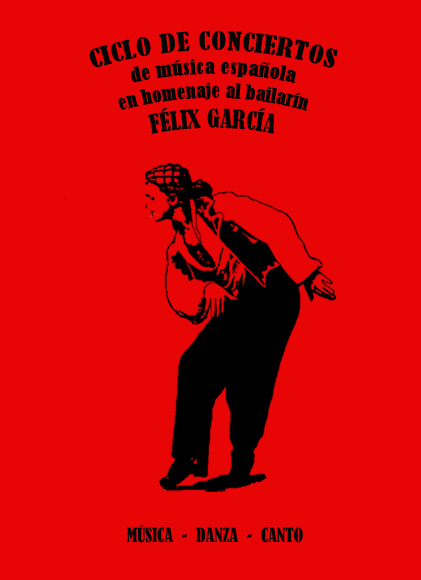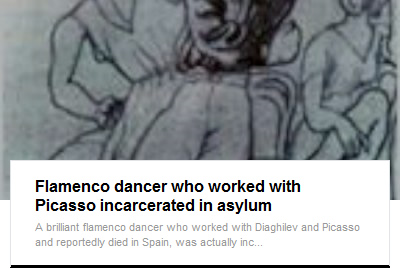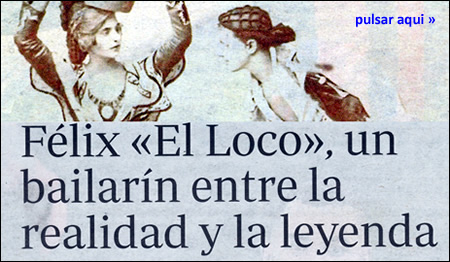|
| |
ANTONIO HERNANDEZ MORENO
|
 |
|
|
 Félix García and the DIAGHILEV'S BALLETS RUSSES Félix García and the DIAGHILEV'S BALLETS RUSSES
|
|
| |
 |
|
In the last fifteen years Antonio Hernandez Moreno has been working in a wide research about the Diaghilev's Ballet Russes in Spain and the private relationship between the composer Manuel de Falla and other artists regarding the creation of the first Spanish ballet, "The Three Cornered Hat" premiered by the Diaghilev troupe in London, 1919. In addition to this, his research focuses on the contribution that the enigmatic and unknown Spanish dancer, Felix Garcia, named with the mistaken and scornful nickname of "Felix el Loco" (Felix de Mad) put in this ballet during its gestation. Felix Garcia -also an artistic nickname- was hired by Diaghilev as dancer of the Ballet Russes in 1918 and also as Massine's private dance teacher and indeed the rest of the company, according to assemble the different Spanish popular dances that Diaghilev decided to be embodied in the early Falla's score, the theatrical pantomime under the title of "The Governor and the miller's wife". In the early summer of 1919 the Ballet Russes started the season in the Alhambra Theatre in London. Every morning Felix assists to the rehearsals of the difficult Spanish rhythms included in Le Tricorne with the rest of the ballet dancers, under the choreographic supervision of Diaghilev and Leonid Massine, the pressing new choreographer of the company -and in fact the new Diaghilev lover- after Nijinsky abrupt dismissal in Spain. Meanwhile the ballet production was being prepared, Felix Garcia, who was going to dance the principal character of the ballet, suffered an important distressing incident. |
|
| |
The key of the research reveals the strange circumstances in which Felix was wrongly and deliberately imprisoned in that mental hospital for the rest of his life, just several weeks before the ballet premiere. Felix never returned to Spain and passed away there in 1941.
Up till now, nobody had found out Felix identity or ascendence (it is believed that he was from Sevilla or Cadiz) neither the strange circumstances he was committed in a South London mental hospital in Epsom in 1919, just several weeks before the ballet premiere in London. The worldwide research in American, British, French and Spanish archives have resulted in a book in which is claimed Felix's good sense and his contribution to the ballet choreography and it success. Throughout the book -a novelized story-, moreover, unpublished facts about other important artists of that time. Thinking on the Three Cornered Hat centenary to be celebrate in 2019 Antonio Hernandez has got in touch with different authorities and mass media here in Spain and in England, organizing a cycle of memorial concerts and lectures in order to pay honor to the figure of the dancer Felix Garcia and erect a memorial stone, financed by his own, on the site Felix was buried.
|
 |
|
 |
| (click on each image to access the link) |
SPANISH MUSIC TRIBUTE CONCERT CYCLE to the dancer "FÉLIX GARCÍA"
This Spanish tribute concert cycle was conceived in October 2016 in Murcia, by the writer and researcher Antonio Hernández Moreno, in collaboration and help with the directors of the Dance Music Conservatory in Murcia, Teresa Seoane and the Higher Conservatory of Music in Murcia, Miguel Angel Centenero, in order to honor the memory of the Spanish musician and dancer Felix Garcia and to commemorate the centenary of the ballet premiere "The Three Cornered Hat" in London (1919-2019) by the Diaghilev's Ballets Russes.
The main purpose of the cycle is the recovery and the performing of works, songs and dances composed by Spanish and foreign composers inspired by traditional music and dance of Spain from the late 19th and early 20th centuries. With this purpose, each concert repertoire will consist of a balanced set of works that will offer the public an enjoyable, interesting and assorted performance.
But ¿Who is Félix García? As Antonio Hernandez explains in his book "Thirty castanets to London", Diaghilev hired in Spain an expert dancer to instruct his dancers and his new choreographer, Leonid Massine, in the difficult Spanish rhythms like the final Jota (played with castanets).
Thanks to Felix's personal commitment and his active involvement in the progress of this ballet, a primitive pantomime theater play -for which Falla had originally composed his music- was transformed and ended up to the first modernist ballet based on Spanish story line and character. The Cubist contribution of Picasso designing the scenery and the costumes, and a definitive and forceful contribution of other composers finishing the score, made possible that The Three Cornered Hat reaches a great success not only the night of its premiere but later on, becoming from then one of the most perfect works of art in modern times. |
• Primer Concierto de Félix García (click to view)
• Segundo Concierto de Félix García (click to view)
• Tercer Concierto de Félix García (click to view)
• Cuarto Concierto de Félix García (click to view)
• Quinto Concierto de Félix García (click to view)
• Sexto Concierto de Félix García (click to view)
• Septimo Concierto de Félix García (click to view)
• Octavo Concierto de Félix García (click to view)
• Noveno Concierto de Félix García (click to view)
• Décimo Concierto de Félix García (click to view)
|
|

 |

|
 |
|
|
|

